

The Classic British Isles Buses Website
Transport in Uzbekistan - 4. Trucks (by Dick Gilbert)
Last updated 29 August 2024
Email Events diary Past events list Classified adverts Classic U.K. Buses Classic Irish Buses Classic Manx Buses
| Aeroplanes in 2015 | Buses in 2015 | Cars in 2015 | Trucks in 2015 | Other transport in 2015 |
This addition to the Classic British Isles Buses Website International Section is the result of a visit to the Central Asian Republic of Uzbekistan in November 2015, and on this page we look at some of the trucks in use there.
The visit to Uzbekistan included many of the historic cities along the ancient Silk Road that used to see camel caravans transporting exotic spices and textiles from China to Europe hundreds of years ago. Much of it survives to this day, but we travelled not by camel, but by Chinese-built tour coach, Spanish-built express train and European Airbus airliner.
Until 1991 Uzbekistan was a largely undeveloped region of the Soviet Union, so there are still quite a few signs of Russian transport influence there, and these were the bits that interested me most. We'll look at them later, but let's get the modern, boring stuff out of the way first - it get's more interesting as you work your way down the page! Many thanks to Dmitry Dedukh for helping me with Russian vehicle identities.
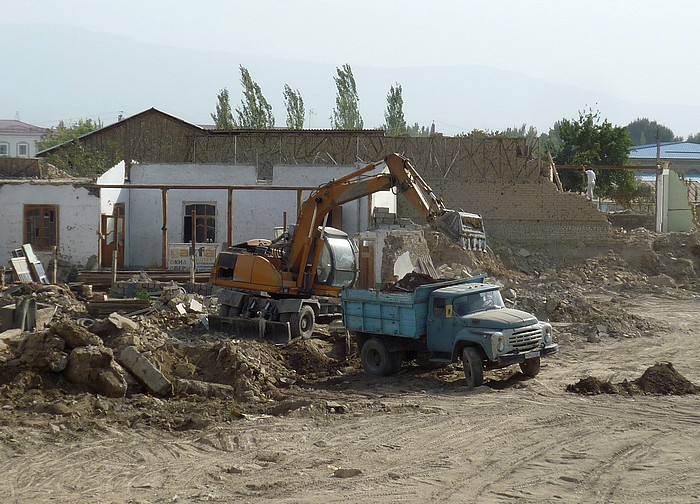
I loved the older Russian trucks in Uzbekistan and here we see a typical ZiL-130 working hard at Shakhrizabz, an ancient city not far from the border with Afghanistan. It was home to Amir Timur (Tamerlane), a ruthless 14th century despot now adopted by Uzbekistan as its national hero, on the basis that it seemed like an improvement on Joseph Stalin, the Soviet superstar they had previously been lumbered with. This picture illustrates that houses are being demolished wholesale to make room for a huge Amir Timur theme park on the site of his vast palace.

Lesson One: The Zil-130 has horizontal slats on its radiator grille (almost always!), whereas the GAZ-53 has vertical slats. Both types of very similar trucks seem to be built in two colour options - blue and white, or khaki.

This is a Zil-130 municipal water tanker in a park in Tashkent. The ZiL-130 has a V8 6-litre engine, and can be powered by diesel oil (like this one - see the fuel tank forward of the rear wheel) or liquid gas.

Here is a close-up view of the Tashkent City Council logo on the ZiL-130 tanker in the previous photo. This type of truck is one of the most numerous manufactured in the Soviet Union, with well over 3 million being made between 1964 and 1994, when production moved from Moscow to the Ural Motor Plant.

This is an early (pre-1978) version of the ZiL-130, identified by the two slats across the radiator grille instead of three. Since I can't read Russian, David Patton tells me that the vehicle on the right is an LPG tanker, probably carrying liquified propane gas destined for home heating. Thanks David.

Now here's the exception to lesson one. This ZiL-130 has been fitted with a nose section (or possibly a whole cab) from a Zil-131 6x6 truck, with vertical slats on the grille. The conversion doesn't seem to have worked out very neatly. This example is gas powered, evidenced by the red gas tank just visible forward of the rear wheel.
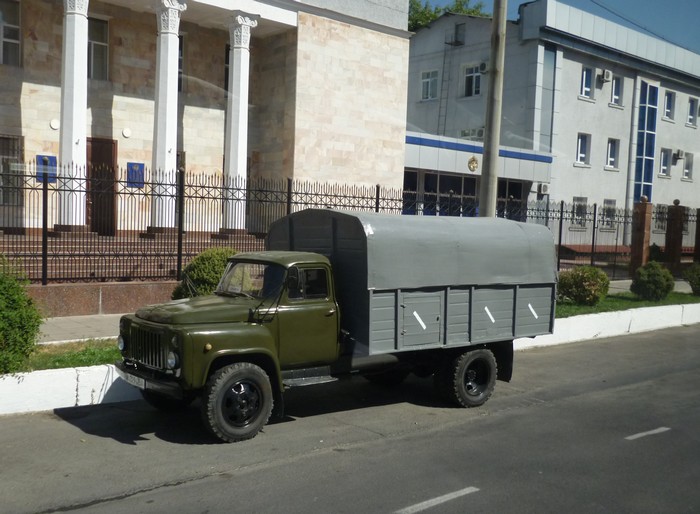
Lesson one, continued. Now, in contrast, we see the very similar GAZ-53, which always has vertical slats on its radiator grille. This is the khaki version, and it looks very smart. The GAZ-53 is a 4-ton truck, if you can persuade it to carry that much.
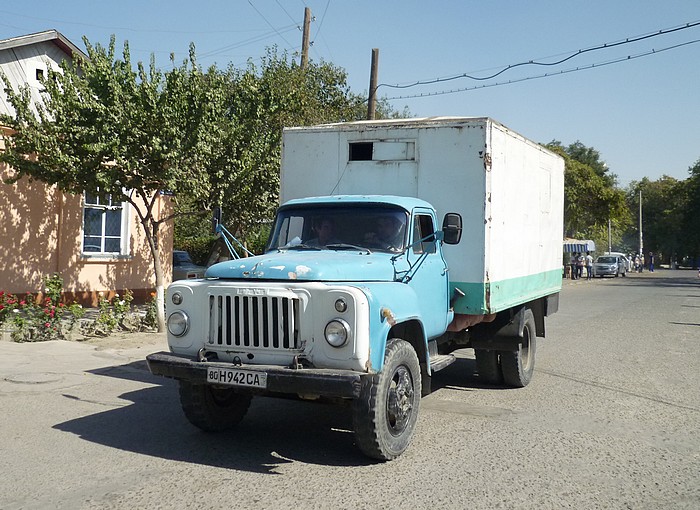
Here is a GAZ-53 box van in standard blue and white. Similar to the ZiL-130 it was built between 1964 and 1993, but has a smaller 4.3 litre V8 engine. Red cylinders just visible on the chassis under the box show that this example runs on LPG.

This is a GAZ-53 water tanker used for washing down the new road that the Koreans were building across the desert between Khiva and Bukhara. The GAZ-53 is nicknamed the Gazon.

This GAZ-53 example was sitting outside someone's house, but didn't look as though it had moved much lately, judging by the layer of dust. It also seems to be un-registered, so perhaps it's up for sale. It has an earlier style of radiator grille used on trucks built before 1983.
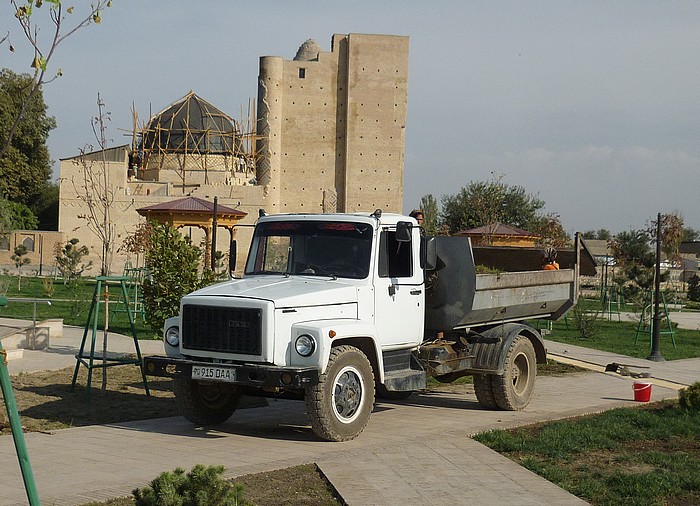
GAZ are still making trucks. Here's a much more modern GAZ 3309 diesel 4.5 ton truck in Shakhrisabz, near the border with Afghanistan. It is participating in the building of a huge theme park to commemorate the 14th century tyrant Amir Timur, Uzbekistan's national hero. The building behind is a mausoleum for two of his sons, as Shakrisabz was the ancestral home. It was intended that Amir Timur would be buried there too, but his tomb lies empty because (for complex reasons) he was buried in Samarkand instead.

Here's something a bit heavier. This is a Ural-4320 6x6 truck designed for off-road work with the Soviet Army - you can put a rocket launcher on the back if you like. Powered by a V8 diesel engine, it went into production in 1976 and is still being made today. The headlights in the bumper indicate that this example is post-1991 and built for civilian (not military) service. The design can be traced back to American World War Two Studebaker army trucks.

And here's another chunky piece of kit. This is a KrAZ-255B fitted with a crane. They are mighty beasts with a 15-litre V8 engine which, it is said, gobble 5 mpg on a good day. It was at a riverside yard near Urgench. You can add extra sections into the crane jib and make it as long as you like. I guess that the brand new Chinese Shacman tippers in the background are an indication of the way things are looking for old Russian equipment these days.
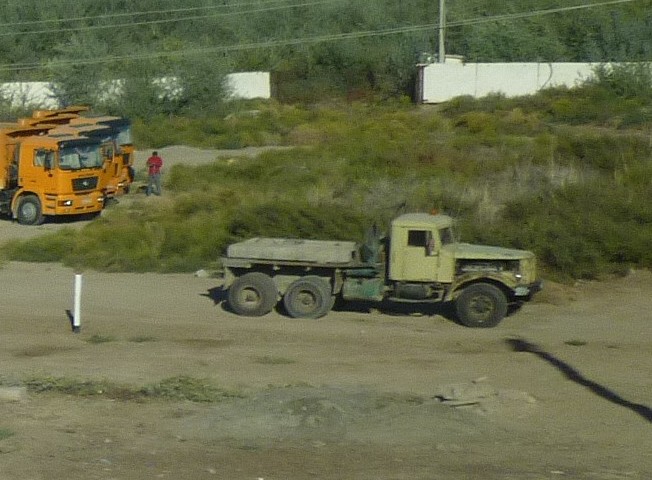
This is another KrAZ-255B (without a crane) at the same site near Urgench. The KrAZ factory at Kremenchuk in Ukraine was founded in 1945, has been building trucks since 1959, and started making the 255B for the Soviet Army in 1965. Production ceased in 1994, but this looks like an early one.

This little fellow is a UAZ 452 made in Ulyanovsk. They have been around for over 40 years and are still being built today. The van version is nicknamed the loaf (because of its shape), the ambulance version is called the pill, and the pickup is known as the tadpole (in Russian, of course).
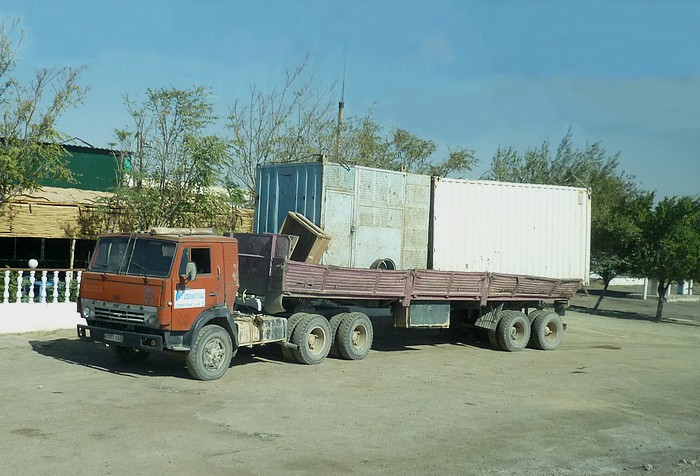
The next former Soviet truck manufacturer is Kamaz, who have been building trucks in Tatarstan since 1976, currently producing over 40,000 trucks per year. This is (I think) a rather aged Kamaz 54112 prime mover with a dodgy old load on a dodgy old trailer.
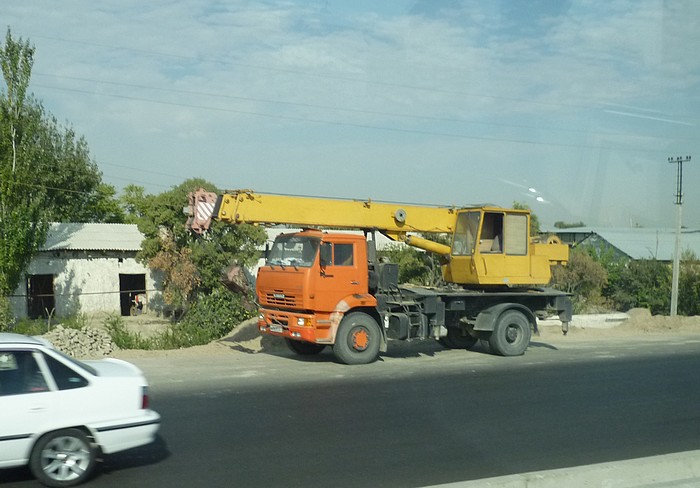
Here is a Kamaz 53605 chassis with a crane on the back - slightly unusual because this type of crane is normally fitted to a 6x6. The 53605 model is still production and has a 10.8 litre V8 diesel engine. Kamaz have a reputation for being very tough, but are gradually being replaced by Chinese products.
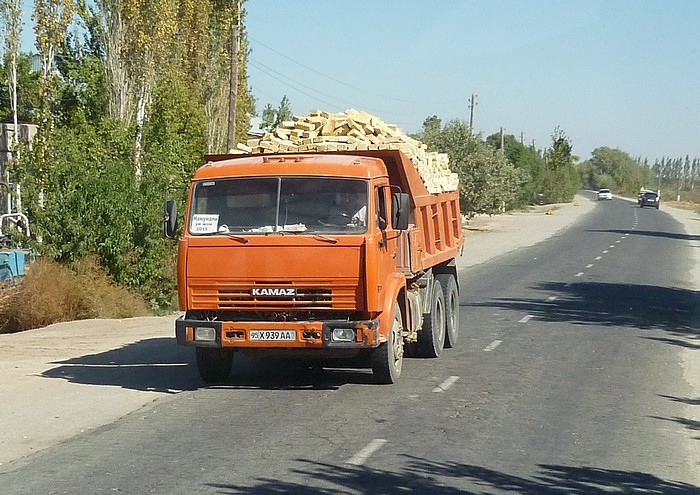
This is a Kamaz 55111 tipper with a load of bricks. I was surprised at the way that Uzbeks transport bricks in tippers, then break lots of them when they dump the load. The 55111 was a very popular 6x4 dump truck with a V8 diesel engine and a 13-ton capacity, manufactured from 1987 to 2012.

My guess is that this is a Kamaz 53215 6x4 11-ton truck pulling a trailer the 300 miles across the desert from Khiva to Bukhara. Some of the road (the bits that are currently being laid by the Koreans) is good, but the rest of it is pretty awful! In the background is one of the strange mobile tin cabins that apparently are (or used to be) used to house road workers.
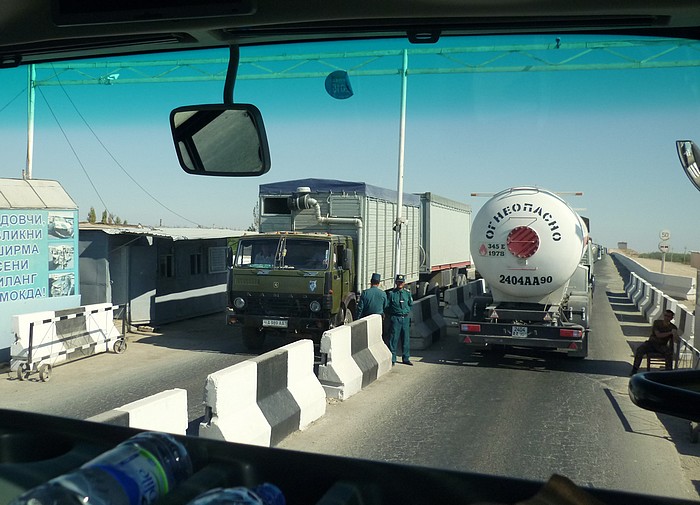
At regular intervals on roads around Uzbekistan are permanent police checkpoints. There's a lot of smuggling going on, and we were not far from Afghanistan - drugs coming out and weapons going in. We were warned not to take photographs at these roadblocks, but I wasn't told that until after I'd taken this one. On the left is probably another Kamaz 53215, and on the right is that LPG tanker again, as seen in the GAZ-53 picture further up the page.
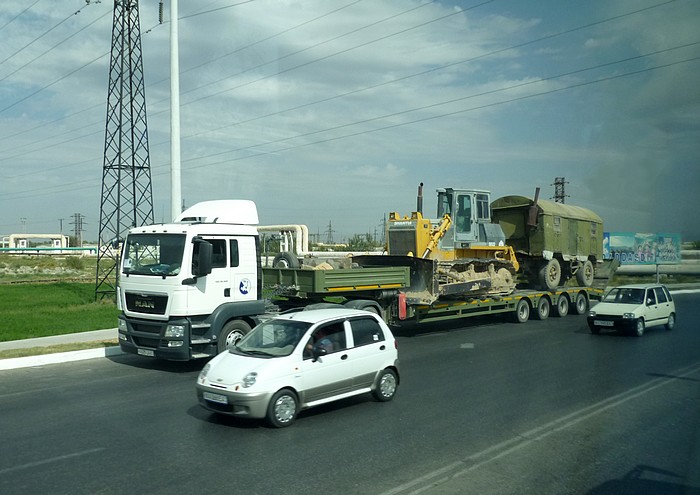
The MAN low loader may be a bit more modern, and so is the Chinese Shantui SD22 bulldozer (with a Cummins 14-litre engine) on the back, but the trailer at the rear is a great piece of old Soviet kit. Presumably this lot is heading for the Korean road-building project out in the desert.
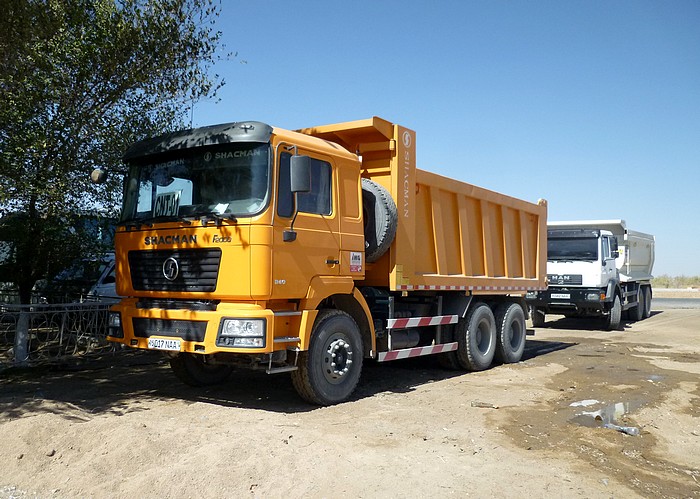
Talking of the Chinese, these brand new orange Shacman F2000 tippers were everywhere - hundreds of them - especially along the stretches of desert road being rebuilt by the Koreans. This, I think, is the 340 h. p. version with 20 tons capacity.

Also seen in the desert in large numbers were these white Chinese Sinotruk tippers. In the foreground is the eastbound carriageway completed, next is the long pile of rubble which is the old road broken up, and beyond that is the new westbound carriageway still being laid. This went on for miles and miles. The trucks are probably the HOWO 6x4 8-litre 371 h. p. diesel 30-ton models. Here the gang is taking a rest, in the hot sun for some reason.
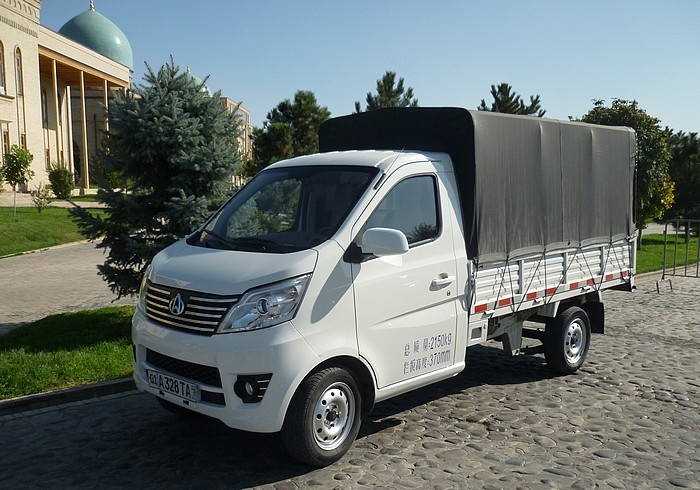
A rather smaller Chinese product is this brand new Chana Star pickup seen in Tashkent. These are made by the Changan Automobile Company and the 1.2 litre engine hauls 1.2 tons.
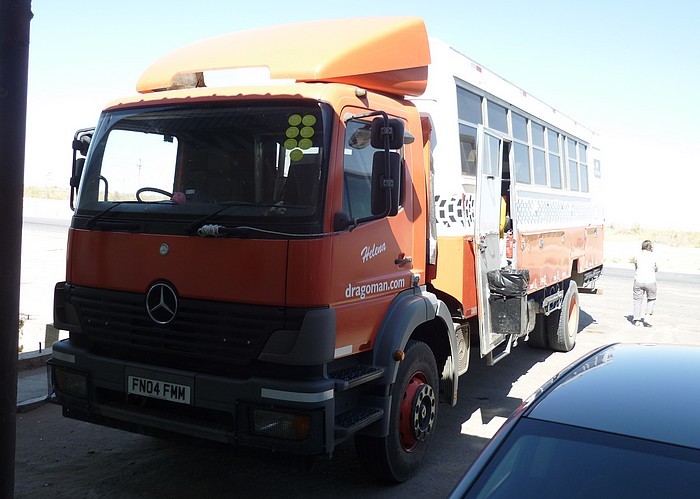
Finally, this is the only British-registered vehicle I saw on the whole trip, and what an unexpected one. Dragoman (which means an interpreter or guide) is an overland tour company in the old-fashioned style, which means travelling in a rugged vehicle and pitching tents overnight. They operate in many parts of Africa, The Americas and Asia, including Uzbekistan. This 2004 Mercedes, Helena, is typical of the fleet and is seen at a mid-desert oasis truck stop at which we were recommended not to eat the food. This Dragoman party did, and I wish them good luck. We were all poisoned at a hotel in Bukhara anyway.
Email Events diary Past events list Classified adverts Classic U.K. Buses Classic Irish Buses Classic Manx Buses
a